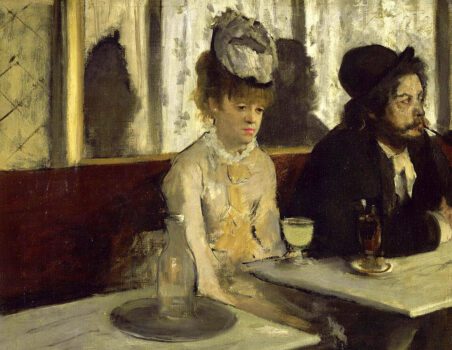What is The Meaning of The Absinthe Drinker Painting by Edgar Degas
A Glimpse into Bohemian Despair
Edgar Degas’ The Absinthe Drinker is one of the most haunting and socially charged works of 19th-century French art. Painted in 1875–76, this enigmatic piece, also known as L’Absinthe, captures a scene of isolation and melancholia that speaks volumes about the Parisian society of its time. Often misunderstood and misinterpreted, the painting is not just a visual commentary on the dangers of substance abuse, but a rich, multi-layered exploration of alienation, modernity, and the fractured human condition.
In this article, we will embark on a deep analytical journey of The Absinthe Drinker, exploring its artistic style, the symbolism behind its figures and composition, the controversy it sparked, its place in Degas’ body of work, and its legacy in art history. We will also address where this important painting resides today and why it remains a subject of continued fascination.
The Artist: Edgar Degas – The Observer of Modern Life
Edgar Degas (1834–1917) was a French artist best known for his works depicting dancers, women in private moments, and everyday urban life. Although often grouped with the Impressionists, Degas diverged significantly from them in both technique and philosophy. He preferred indoor scenes and was obsessed with composition and structure, often employing rigorous draftsmanship over the looser brushwork of his contemporaries.
Degas was a master observer of the modern condition. Where Monet saw light and nature, Degas saw the emotional truth behind the city’s façade. He painted people not as idealized subjects but as deeply human figures, flawed, tired, anxious, lost in thought. This psychological depth is what makes The Absinthe Drinker so compelling.
The Painting: Description and Composition
The Absinthe Drinker features two figures seated side by side in the Café de la Nouvelle-Athènes in Paris, a popular gathering spot for artists and intellectuals. The woman, modelled by actress Ellen Andrée, sits in the foreground with a blank, weary expression, gazing vacantly at a glass of absinthe on the table before her. The man beside her, played by the artist Marcellin Desboutin, stares off into space in an equally disengaged state.
The composition is masterfully imbalanced. The woman’s body slouches forward while her gaze drops downward, conveying defeat or disconnection. The man leans back, his arm draped over the bench, lost in thought. Neither acknowledges the other. The space between them, although narrow, feels like an emotional chasm. The tables are pushed closely, almost claustrophobically, emphasizing confinement and lack of escape.
Degas uses a muted palette, beiges, browns, and dirty greens, to reinforce the depressive mood. There is no vibrancy, no warmth. Light falls in flat planes, and the figures are anchored in a dull, oppressive environment. The absinthe, a green alcoholic beverage associated with bohemian Paris but also with madness and decay, becomes a quiet yet potent character in its own right.
The Meaning: What Is Happening in the The Absinthe Drinker Painting?
On the surface, The Absinthe Drinker appears to be a simple depiction of two people drinking in a Parisian café. But the psychological depth of the scene opens it up to more complex interpretations. This is not a celebratory scene of leisure or indulgence; rather, it captures a moment of quiet despair and social alienation.
The woman is the focal point, and her expression is key to the painting’s emotional impact. She is not glamorous, seductive, or lively. Her face is passive and resigned, her body limp. The presence of absinthe in front of her heightens the sense of decay, not just physical, but existential. Absinthe was known for its hallucinogenic properties and had become a symbol of moral decline in 19th-century France.
The man beside her is equally lost in his own world, disconnected from both her and the viewer. This shared solitude becomes the true subject of the painting. It is not just about addiction or a vice; it is about the emotional and social void that modern life can create.
Symbolism and Interpretation: Layers of Meaning
Absinthe as a Symbol
Absinthe, often called “the green fairy,” was both romanticized and demonized in the 19th century. It was the drink of artists, writers, and those living on society’s fringe. However, it also became synonymous with addiction, insanity, and poverty. In Degas’ painting, absinthe serves not just as a beverage but as a symbol of self-destruction and societal neglect.
The fact that the woman stares at her drink without touching it suggests a deeper commentary: it is not about indulgence but entrapment. She is held in a moment of existential paralysis, where even the act of drinking seems too purposeful.
Alienation and Modernity
Degas was deeply interested in the changes wrought by urbanization and industrialization. Paris, in the late 19th century, was a city in flux, a place of both opportunity and profound dislocation. People were increasingly anonymous, and social bonds were loosening. The Absinthe Drinker captures this sense of isolation amidst a bustling metropolis.
The two figures are physically close but emotionally distant, a visual metaphor for urban loneliness. Their anonymity within a public space mirrors the experience of many modern city dwellers: surrounded by people yet profoundly alone.
Gender and Morality
Some critics of Degas’ time accused him of portraying the woman in a judgmental light, as a cautionary tale of female depravity. However, contemporary interpretations often challenge this view. Rather than moralizing, Degas may be offering a sympathetic portrait of a woman worn down by societal pressures, poverty, and limited choices.
Her lack of glamor is notable. Degas does not sexualize or romanticize her; he presents her as a real human being, stripped of artifice. In doing so, he gives voice to a broader narrative of marginalization, particularly of women in urban modernity.
Artistic Techniques and Stylistic Choices
Degas was a pioneer in merging classical technique with modern subjects. He frequently used pastels and oils, though The Absinthe Drinker is rendered in oil on canvas. His love for Japanese prints (Japonisme), with their unusual perspectives and framing, is evident in the painting’s composition. The sharp diagonal lines, the cropping of figures, and the seemingly “off-center” balance evoke the influence of ukiyo-e woodblock prints.
Unlike the Impressionists, who painted en plein air and sought to capture the fleeting effects of light, Degas worked meticulously in the studio. He often staged his scenes with models, sometimes painting dozens of studies before arriving at a final composition. This laborious process is evident in the controlled, almost sculptural quality of the figures.
Degas also employed a subtle interplay of gazes, or rather, the absence of them. The characters never look at each other or at the viewer. This lack of visual connection further underscores the themes of emotional detachment and psychological withdrawal.
Reception and Controversy
When The Absinthe Drinker was first exhibited in London in 1893, it caused a scandal. Many viewers were shocked by what they perceived as an immoral subject. The painting was decried as an “ugly,” “disgusting” portrayal of vice. One critic even suggested that Degas had hired “professional drunkards” to sit for the piece.
Degas, ever the provocateur, defended his work, stating, “I have painted reality.” He rejected sentimentalism and idealism, instead forcing the viewer to confront uncomfortable truths.
In time, however, critical opinion shifted. Today, the painting is regarded not as a moral judgment but as a sensitive, psychologically rich portrayal of urban disaffection. It has become a key work in the study of modernism and the evolution of realist art.
The Painting’s Legacy and Influence
The Absinthe Drinker has inspired countless interpretations and homages in literature, film, and visual art. It stands alongside other iconic works, like Manet’s The Bar at the Folies-Bergère and Toulouse-Lautrec’s At the Moulin Rouge, in capturing the complexities of modern life.
Its psychological depth paved the way for later developments in expressionism and modernist portraiture. Artists such as Edward Hopper and Lucian Freud, who similarly explored themes of isolation and introspection, owe a debt to Degas’ pioneering vision.
The Current Location of The Absinthe Drinker Painter
Today, The Absinthe Drinker is housed in the Musée d’Orsay in Paris, one of the world’s premier institutions for 19th-century art. Visitors to the museum can view the painting in person, often displayed alongside other works by Degas and his contemporaries.
The Musée d’Orsay provides an ideal context for the painting, as it allows viewers to place Degas’ work within the broader currents of Impressionism, Realism, and early Modernism. Seeing the painting in person also allows one to appreciate its subtle textures, color modulations, and the quiet power of its composition, details that are often lost in reproduction.
Conclusion: A Mirror to the Human Condition
Edgar Degas’ The Absinthe Drinker is far more than a depiction of two people in a café. It is a profound meditation on the human experience, on isolation, addiction, modernity, and the quiet despair that often lurks beneath the surface of everyday life.
Rather than passing judgment, Degas offers a window into the psychological states of his subjects, encouraging empathy over condemnation. The painting endures not because of its scandalous history or striking imagery alone, but because it captures something universally human: the search for meaning in a world that often feels indifferent.
More than a century later, the silent figures in The Absinthe Drinker still speak to us, reminding us that behind every face is a story, and that even in silence, there is a depth worth exploring.
Quick Facts Recap:
Title: The Absinthe Drinker (also known as L’Absinthe)
Artist: Edgar Degas
Date: 1875–1876
Medium: Oil on canvas
Style: Realism / Impressionism (with strong influences of Modernism and Japonisme)
Location: Musée d’Orsay, Paris, France
Subject: Two isolated individuals seated in a café, with absinthe as a central motif
Themes: Alienation, addiction, modernity, gender roles, psychological realism




